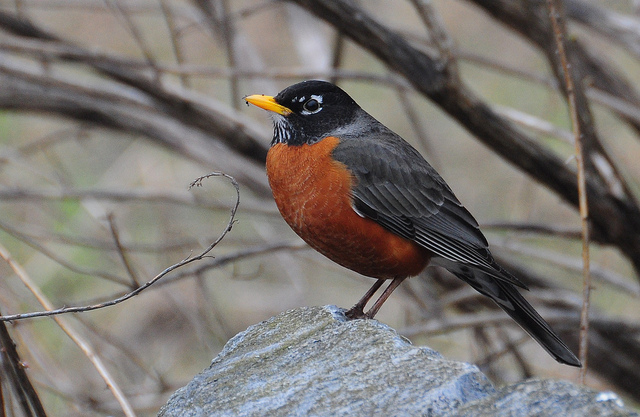“The First Robin” is a Safed the Sage story by William Eleazar Barton collected in “The Wit And Wisdom Of Safed The Sage” (1919). I use it as a point of departure for how to determine if your startup’s initial journey through Winter is coming to an end.
The First Robin
Now the Winter had been Long, and Very Cold, and the Snow had been deep, and Spring was not yet come. And I rose early in the morning, and I looked out of mine Window, and Behold a Robin.

And I called unto Keturah, and said, Come quickly, and see thou hasten thine arrival at the Window. For here is a Friend of ours that is Come from a Far Country to Visit us.
And Keturah came to the Window, and she also beheld the Robin.
Now the Robin looked at us, and hopped about upon the Cold and Bare Ground, and looked for the Early Worm, but the Bird was Earlier than the Worm. And Keturah went to her Kitchen to see what she might find that the Robin would eat.
And I spake to the Robin, and said :
Behold thou has been where it was Warm, and the Sun did Shine. And thou could have stayed there. But here thou art. And thou comed while it is yet Winter, for the Prophecy of Spring is in thy Blood. Thy faith is the substance of things hoped for and the evidence of things not seen. Thou has come many miles, yea hundreds of miles, to a land that lies desolate, because thou has within thy soul the assurance that Spring is near. Oh, that there were in human life some assurance that would send men forth to their High Destiny with as compelling a Conviction!
And I thought of the Eye, that it is formed in darkness, but formed for the light ; and the Ear that is wondrously shaped in Silence, but made for the hearing of Music; and of the Human Soul that is born into a world where Sin is, yet born with an assurance of Righteousness.
And I blessed the Little Bird that had caused me to think of these things.
And I went forth among men that day, and they said, Salaam, Safed. Behold is it not a cold and long Winter?
And I said, Speak to me no more of Winter.
And they said, Wherefore should we not speak of Winter? Behold the Thermometer and the Empty Coal Bin.
But I held mine Head Proudly and I said : Speak to me not of Winter. Behold, on this morning I did see the First Robin. For me henceforth it is Spring.
William Eleazar Barton “The First Robin” in “The Wit And Wisdom Of Safed The Sage” (1919)
Barton wrote a sequel “The Robin and the Cherries.”
Winter is Ending
For my Silicon Valley readers who don’t know what Winter is and what it means to see a robin–a harbinger of Spring–it’s a wonderful feeling. Robins can return even when there is snow on the ground and it looks like Winter may never end. If you have been talking to prospects, trying to determine where the smarter ones–those who can understand the problem you solve and the value of how you solve it–hang out, there is a wonderful moment when you hear one of the following questions:
- “How do you price this?”
- “Who else is using this?”
- “What test data have you used to verify this?”
- “I have some tests I would like to run, how do we do a trial or evaluation?”
- “How do we get started?”
These are all good questions to have answers for so that the first time you hear them (perhaps after a dozen or so “That was very interesting, you have given us a lot to think about, let me get back to you next week after we have had a chance to huddle and plan our next steps.”).
Related Blog Posts
- The Fish and the Bait
- 40 Tips for B2B Customer Interviews
- Six Elements to Extract In Customer Discovery Interview
- 5 Ways To Start Customer Discovery Interviews
- Early Customer Conversations: Use Appreciative Inquiry and Amplify Positive Deviance
Safed the Sage Stories
Barton published 326 of these stories in five volumes between 1917 and 1925:
- The Parables of Safed the Sage (1917)
- The Wit and Wisdom of Safed the Sage (1919) In the foreword Barton explains the origin of the name Safed:
“So far as we know, no man except the author of these Parables bears or has borne that name. He did not wish to choose a name either from the Bible or from the Arabian Nights, and so invented one. The name was not, however, invented wholly out of nothing. There is in Northern Galilee a village called Safed or Sefet, lying north and a little west from the Sea of Galilee, and plainly visible from the traditional site of the Sermon on the Mount, and believed to be the “city set on a hill, which cannot be hid.” The author visited this site some years ago, and the name came to him somewhat spontaneously as a convenient one for the character which he has assumed in these chapters - Safed and Keturah (1921)
- More Parables of Safed the Sage (1923)
- Fun and Philosophy of Safed the Sage (1925)
Garth Rosella and Stan Flewelling collected 80 of William Eleazar Barton’s stories in “Parables of a Country Parson” (a reprint of their earlier “Millionaire and the Scrub Lady“). Paul Spite has republished all five books, see “Archeologos Press: The Parables of the Safed the Sage Series”
Photo Credit: Joe Cosentino “Robin“
